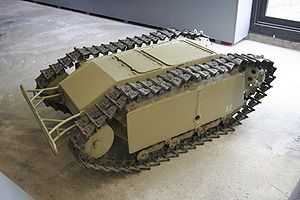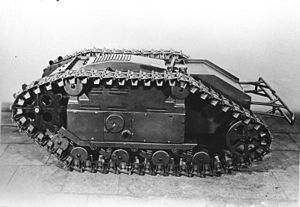Goliath tracked mine
| Goliath Sd.kfz 302 | |
|---|---|

An SdKfz. 302, displayed at the Deutsches Panzermuseum, Munster (2005)
|
|
| Type | Demolition vehicle |
| Place of origin | Germany |
| Service history | |
| In service | 1942-1945 |
| Used by | Nazi Germany, |
| Production history | |
| Designed | 1942 |
| Manufacturer | Borgward and Zundapp. |
| Produced | 1942–1944 |
| Number built | 7564 |
| Specifications | |
| Weight | 370 kg (820 lb) |
| Length | 1.5 m (4.9 ft) |
| Width | 0.85 m (2.8 ft) |
| Height | 0.56 m (1.8 ft) |
| Crew | one remote operator |
|
|
|
| Armor | 5mm |
|
Main
armament |
60 kg (130 lb) explosive charge |
| Engine | Two Electric Motors 2 x 2.5 kw |
|
Operational
range |
1.5 km (0.93 mi) on-road; 0.75 km (0.47 mi) off-road. |
| Goliath Sd.kfz 303 | |
|---|---|

An SdKfz. 303, the petrol powered version of the Goliath
|
|
| Type | Demolition vehicle |
| Place of origin | Germany |
| Service history | |
| In service | 1943-1945 |
| Used by | Nazi Germany, |
| Production history | |
| Designed | 1942 |
| Manufacturer | Zundapp and Zachertz |
| Produced | 1943–1945 |
| Number built | 4929, both the model a and model b |
| Specifications | |
| Weight | 430 kg (950 lb) |
| Length | 1.69 m (5.5 ft) |
| Width | 0.91 m (3.0 ft) |
| Height | 0.62 m (2.0 ft) |
| Crew | none |
|
|
|
| Armor | 10mm |
|
Main
armament |
100 kg (220 lb) explosive charge |
| Engine | Zündapp SZ7 / 2-cylinder 12.5hp |
|
Operational
range |
12 km (7.5 mi) on-road; 7 km (4.3 mi) off-road. |
The Goliath tracked mine - complete German name: Leichter Ladungsträger Goliath (Sd.Kfz. 302/303a/303b) - was a remote controlled German-engineered demolition vehicle, also known as the beetle tank to the Allies.
Employed by the Wehrmacht during World War II. It carried 60 or 100 kilograms (130 or 220 lb) of high explosives, depending on the model, and was intended to be used for multiple purposes, such as destroying tanks, disrupting dense infantry formations, and demolition of buildings and bridges.
In late 1940, after recovering the prototype of a miniature tracked vehicle developed by the French vehicle designer Adolphe Kégresse near the Seine, the Wehrmacht's ordnance office directed the Carl F.W. Borgward automotive company of Bremen, Germany to develop a similar vehicle for the purpose of carrying a minimum of 50 kg of explosives. The result was the SdKfz. 302 (Sonderkraftfahrzeug, ‘special-purpose vehicle’), called the Leichter Ladungsträger (‘light charge carrier’), or Goliath, which carried 60 kilograms (130 lb) of explosives. The vehicle was steered remotely via a joystick control box. The control box was attached to the Goliath by a triple-strand cable connected to the rear of the vehicle, for transmitting power to the electric driven version. Two of the strands were used to move and steer the Goliath, while the third was used for detonation. The Goliath had 650 metres (2,130 ft) of cable. Each Goliath was disposable, being intended to be blown up with its target. Early model Goliaths used an electric motor but, as these were costly to make (3000 Reichsmarks) and difficult to repair in a combat environment, later models (known as the SdKfz. 303) used a simpler, more reliable gasoline engine.
Goliaths were used on all fronts where the Wehrmacht fought, beginning in early 1942. They were used principally by specialized Panzer and combat engineer units. Goliaths were used at Anzio in Italy in April 1944, and against the Polish resistance during the Warsaw Uprising 1944. A few Goliaths were also seen on the beaches of Normandy during D-Day, though most were rendered inoperative due to artillery blasts severing their command cables. A small number of Goliaths were also encountered by allied troops in the Maritime Alps following the landings in southern France in August 1944, with at least one being used successfully against a vehicle of the 509th Parachute Infantry Battalion.
...
Wikipedia
